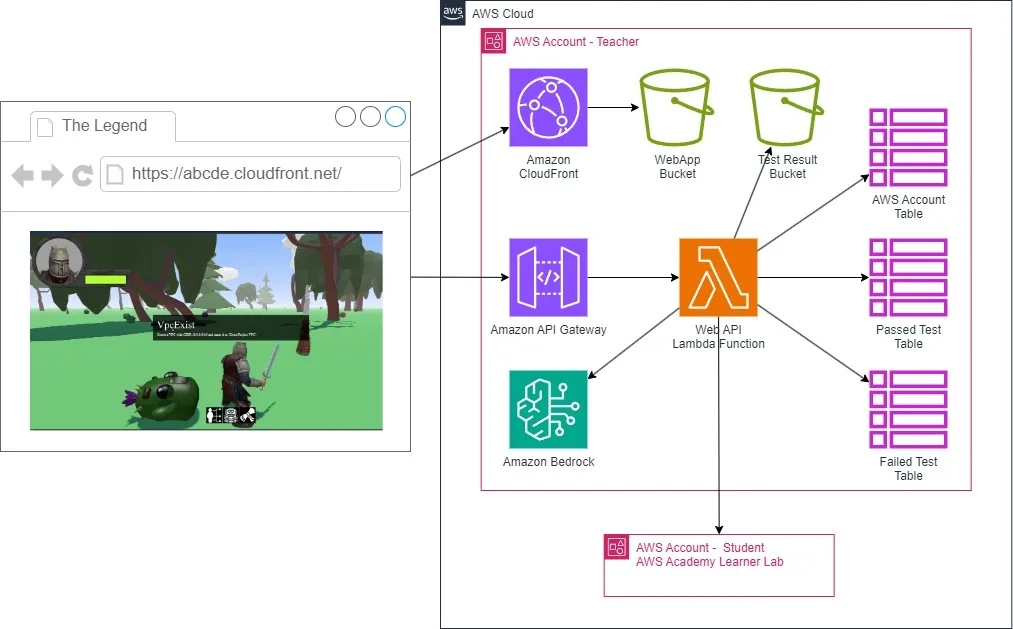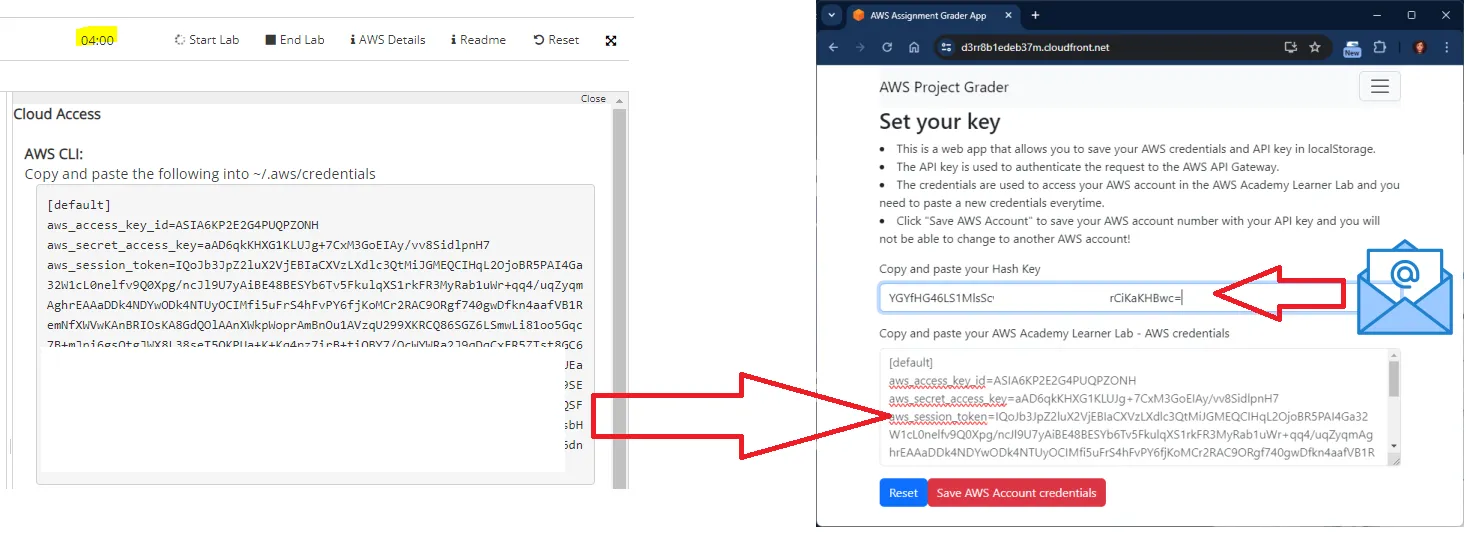The Legend of AWS Warrior: A Free Opensource 3D RPG Adventure Game with Generative AI for learning AWS
"The Legend of AWS Warrior" is an innovative approach to learning AWS through 3D RPG gaming at Hong Kong Institute of Information Technology (HKIIT). By integrating various AWS services such as Amazon Bedrock, AWS Lambda, Amazon S3, and Amazon DynamoDB into an AWS SAM serverless application, it offers a practical, hands-on experience with AWS Academy.
First and foremost, we extend our gratitude to SimonDev. The game is a modification of his repository, Quick_3D_RPG.







- The GameClass attribute defines the order and timeout for game-related tasks.
- The GameTask attribute provides the raw instructions, time limit, and reward for specific tasks. Although the time limit is not currently in use, in the next version, the system will calculate the time between students receiving the task and completing it. This adjustment will allow us to fine-tune rewards based on completion time.
1
2
3
4
5
6
7
8
9
10
11
12
13
14
15
16
17
18
19
20
21
22
23
24
25
26
27
28
29
30
31
32
33
34
35
36
37
38
39
40
41
42
43
44
45
46
47
48
49
50
using Amazon.EC2;
using Amazon.EC2.Model;
using NUnit.Framework;
using ProjectTestsLib.Helper;
namespace ProjectTestsLib;
[]
public class T02_VpcTest: AwsTest
{
private AmazonEC2Client? Ec2Client { get; set; }
private string? VpcId { get; set; }
[]
public new void Setup()
{
base.Setup();
Ec2Client = new AmazonEC2Client(Credential);
VpcId = QueryHelper.GetVpcId(Ec2Client);
}
[]
public void TearDown()
{
Ec2Client?.Dispose();
}
[]
[]
public async Task Test01_VpcExist()
{
var describeVpcsRequest = new DescribeVpcsRequest();
describeVpcsRequest.Filters.Add(new Filter("tag:Name", ["Cloud Project VPC"]));
var describeVpcsResponse = await Ec2Client!.DescribeVpcsAsync(describeVpcsRequest);
Assert.That(describeVpcsResponse.Vpcs, Has.Count.EqualTo(1));
}
[]
[]
public async Task Test02_VpcOf4Subnets()
{
DescribeSubnetsRequest describeSubnetsRequest = new();
describeSubnetsRequest.Filters.Add(new Filter("vpc-id", [VpcId]));
var describeSubnetsResponse = await Ec2Client!.DescribeSubnetsAsync(describeSubnetsRequest);
Assert.That(describeSubnetsResponse.Subnets.Count(), Is.EqualTo(4));
var expectedCidrAddresses = new string[] { "10.0.0.0/24", "10.0.1.0/24", "10.0.4.0/22", "10.0.8.0/22" };
List<string> acturalCidrAddresses = describeSubnetsResponse.Subnets.Select(c => c.CidrBlock).ToList();
Assert.That(acturalCidrAddresses, Is.EquivalentTo(expectedCidrAddresses));
}
}1
2
3
4
5
6
7
8
9
10
11
12
13
14
15
16
17
18
19
20
21
ApiGatewayApi:
Type: AWS::Serverless::Api
Properties:
Name: !Sub "${AWS::StackName}-api"
StageName: Prod
Cors:
AllowOrigin: !Sub "'https://${CloudFrontDistribution.DomainName}'"
MaxAge: "'600'"
AllowCredentials: true
APIUsagePlan:
Type: 'AWS::ApiGateway::UsagePlan'
Properties:
ApiStages:
- ApiId: !Ref ApiGatewayApi
Stage: Prod
Description: To usage plan and api key in REST API.
Quota:
Limit: 2880
Period: DAY
UsagePlanName: "grader-usage-plan"1
2
3
4
5
6
7
8
9
10
11
12
13
14
15
16
17
18
19
20
21
22
23
24
25
26
27
28
29
30
31
32
GameFunction:
Type: AWS::Serverless::Function
Properties:
CodeUri: ./src/ServerlessAPI
Handler: ServerlessAPI::ServerlessAPI.Functions.GameFunction::FunctionHandler
Policies:
- Statement:
- Effect: Allow
Action: 'bedrock:*'
Resource: '*'
- DynamoDBCrudPolicy:
TableName: !Ref PassedTestTable
- DynamoDBCrudPolicy:
TableName: !Ref FailedTestTable
- DynamoDBCrudPolicy:
TableName: !Ref AwsAccountTable
Environment:
Variables:
PASSED_TEST_TABLE: !Ref PassedTestTable
FAILED_TEST_TABLE: !Ref FailedTestTable
AWS_ACCOUNT_TABLE: !Ref AwsAccountTable
SECRET_HASH: !Ref SecretHash
Events:
ApiEvent:
Type: Api
Properties:
Path: /game
Method: GET
RestApiId:
Ref: ApiGatewayApi
Auth:
ApiKeyRequired: true1
2
3
4
5
6
7
Globals:
Api:
TracingEnabled: true
Cors:
AllowMethods: "'*'"
AllowHeaders: "'*'"
AllowOrigin: "'*'"
1
2
3
4
5
6
7
8
9
10
11
12
13
14
15
16
17
public static APIGatewayHttpApiV2ProxyResponse CreateResponse(HttpStatusCode statusCode, object message)
{
return new APIGatewayHttpApiV2ProxyResponse
{
StatusCode = (int)statusCode,
Body = JsonSerializer.Serialize(message, new JsonSerializerOptions
{
PropertyNamingPolicy = new LowerCaseFirstCharNamingPolicy()
}),
Headers = new Dictionary<string, string>
{
{ "Access-Control-Allow-Origin", "*" },
{ "Access-Control-Allow-Methods", "GET, POST, PUT, DELETE, OPTIONS" },
{ "Access-Control-Allow-Headers", "Content-Type" }
}
};
}

- Random Message Generation: Sometimes, it returns a randomly generated message using the Amazon Bedrock model with the ID amazon.titan-text-express-v1.
- Task Retrieval: If not generating a random message, it checks the PassedTestTable in Amazon DynamoDB. If there’s an incomplete task, it returns the details of the next task to the student. To extract task details, the function uses reflection on the GameClassAttribute and GameTaskAttribute.
1
2
3
4
5
6
7
8
9
10
11
12
13
14
15
16
17
18
19
20
if (new Random().NextDouble() < 0.5)
{
return new JsonResult(await awsBedrock.RandomNPCConversation());
}
var passedTests = await dynamoDB.GetPassedTestNames(user.Email);
logger.LogInformation($"Passed tests: {string.Join(", ", passedTests)}");
var tasks = GetTasksJson();
var filteredTasks = tasks.Where(t => !t.Tests.All(passedTests.Contains));
if (string.IsNullOrEmpty(mode))
{
return new JsonResult(filteredTasks);
}
var t = filteredTasks.Take(1).ToArray();
if (new Random().NextDouble() < 0.7)
{
t[0].Instruction = await awsBedrock.RewriteInstruction(t[0].Instruction);
}
return new JsonResult(t);1
2
3
4
5
6
7
8
9
10
11
12
13
14
15
16
17
18
19
20
21
22
23
24
25
26
27
28
29
30
31
32
33
34
35
36
37
38
39
40
41
42
43
44
45
46
47
48
49
50
51
52
53
54
55
56
57
58
59
60
61
62
63
64
65
66
67
68
69
70
71
72
73
74
75
76
77
78
79
80
81
82
83
84
85
using System.Text.Json.Nodes;
using Amazon;
using Amazon.BedrockRuntime;
using Amazon.BedrockRuntime.Model;
using Amazon.Lambda.Core;
using Amazon.Util;
namespace ServerlessAPI.Helper;
public class AwsBedrock
{
private readonly ILambdaLogger logger;
public AwsBedrock(ILambdaLogger logger)
{
this.logger = logger;
}
public async Task<string> RandomNPCConversation(){
string prompt = """
Write a short sentence in less than 20 words to the AWS warrior to encorage him to fight the monster.
""";
return await InvokeTitanTextG1Async(prompt);
}
public async Task<string> RewriteInstruction(string instruction)
{
string prompt =
"""
<Message>
""" + instruction +
@"""
</Message>
Rewrite the message with the tone as a girl in age 20 and ask for help from the AWS warrior.
""";
return await InvokeTitanTextG1Async(prompt);
}
private async Task<string> InvokeTitanTextG1Async(string prompt)
{
string titanTextG1ModelId = "amazon.titan-text-express-v1";
AmazonBedrockRuntimeClient client = new(RegionEndpoint.USEast1);
string payload = new JsonObject()
{
{ "inputText", prompt },
{ "textGenerationConfig", new JsonObject()
{
{ "maxTokenCount", 1024 },
{ "temperature", 1f },
{ "topP", 0.6f }
}
}
}.ToJsonString();
string generatedText = "";
try
{
InvokeModelResponse response = await client.InvokeModelAsync(new InvokeModelRequest()
{
ModelId = titanTextG1ModelId,
Body = AWSSDKUtils.GenerateMemoryStreamFromString(payload),
ContentType = "application/json",
Accept = "application/json"
});
if (response.HttpStatusCode == System.Net.HttpStatusCode.OK)
{
var results = JsonNode.ParseAsync(response.Body).Result?["results"]?.AsArray();
return results is null ? "" : string.Join(" ", results.Select(x => x?["outputText"]?.GetValue<string?>()));
}
else
{
logger.LogError("InvokeModelAsync failed with status code " + response.HttpStatusCode);
}
}
catch (AmazonBedrockRuntimeException e)
{
logger.LogError(e.Message);
}
return generatedText;
}
}1
2
3
4
5
6
7
8
9
10
11
12
13
14
15
16
17
18
private void RunTestProcess(AwsTestConfig awsTestConfig, string tempDir, string tempCredentialsFilePath, out StringWriter strWriter, out int returnCode)
{
var filter = GetFilter(awsTestConfig);
strWriter = new StringWriter();
var autoRun = new AutoRun(typeof(Constants).GetTypeInfo().Assembly);
var runTestParameters = new List<string>
{
"/test:"+nameof(ProjectTestsLib),
"--work=" + tempDir,
"--output=" + tempDir,
"--err=" + tempDir,
"--params:AwsTestConfig=" + tempCredentialsFilePath + ";trace=" + awsTestConfig.Trace
};
runTestParameters.Insert(1, "--where=" + filter);
logger.LogInformation(string.Join(" ", runTestParameters));
returnCode = autoRun.Execute([.. runTestParameters], new ExtendedTextWrapper(strWriter), Console.In);
logger.LogInformation("returnCode:" + returnCode);
}1
=IMPORTDATA("https://xxxx.execute-api.us-east-1.amazonaws.com/api/keygen?email="&I117&"&hash=abcdefg")
Then, we use mail merge to send the hash key to students.
1
2
3
4
5
6
7
8
9
10
11
12
13
14
15
16
17
18
19
20
21
22
23
24
25
26
27
28
29
30
31
32
33
34
35
36
37
38
39
40
41
42
43
44
45
46
47
48
49
50
51
52
53
54
55
56
57
58
59
60
61
62
63
64
65
66
67
68
69
70
71
72
73
74
75
76
77
{
"StartAt": "Add empty LastEvaluatedKey",
"States": {
"Add empty LastEvaluatedKey": {
"Type": "Pass",
"Next": "Scan",
"Result": {
"LastEvaluatedKey": null
},
"ResultPath": "$"
},
"Scan": {
"Type": "Task",
"Next": "Map",
"Parameters": {
"TableName": "CloudProjectMarker-AwsAccountTable-160W5ZEFD9QSA",
"ProjectionExpression": "#User",
"ExpressionAttributeNames": {
"#User": "User"
},
"ExclusiveStartKey.$": "$.LastEvaluatedKey"
},
"Resource": "arn:aws:states:::aws-sdk:dynamodb:scan"
},
"Map": {
"Type": "Map",
"Next": "Check for more",
"ItemProcessor": {
"ProcessorConfig": {
"Mode": "INLINE"
},
"StartAt": "Lambda Invoke",
"States": {
"Lambda Invoke": {
"Type": "Task",
"Resource": "arn:aws:states:::lambda:invoke",
"OutputPath": "$.Payload",
"Parameters": {
"FunctionName": "${StepFunctionGraderFunctionArn}",
"Payload.$": "$"
},
"End": true
}
}
},
"Label": "Map",
"MaxConcurrency": 100,
"ItemsPath": "$.Items",
"ResultPath": null,
"ItemSelector": {
"Email.$": "$$.Map.Item.Value.User.S"
}
},
"Check for more": {
"Type": "Choice",
"Choices": [
{
"Variable": "$.LastEvaluatedKey",
"IsPresent": true,
"Next": "Add new LastEvaluatedKey"
}
],
"Default": "Done"
},
"Done": {
"Type": "Succeed"
},
"Add new LastEvaluatedKey": {
"Type": "Pass",
"Next": "Scan",
"Parameters": {
"LastEvaluatedKey.$": "$.LastEvaluatedKey"
},
"ResultPath": null
}
}
}

